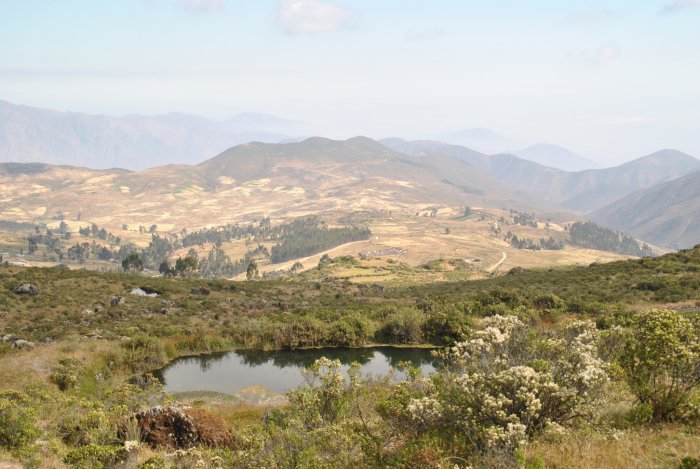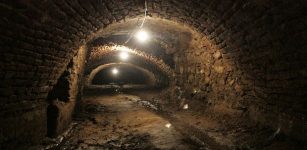Ancient Irrigation System Could Boost Water Availability In Peru
Conny Waters - AncientPages.com - It’s not the first time scientists rely on ancient knowledge to solve modern crisis. This time, researchers are investigating how it’s possible to revive ancient water systems to boost water ability in Peru.
Peru is often overwhelmed with rain in the wet season -- but by the time the dry season comes, water is scarce.
These factors, together with Lima's rapidly growing population, mean the city struggles to supply water to its 12 million residents during the dry months of May to October.
Diversion canal in Peru. Credit: Caroline Brogan
The indigenous peoples of Peru faced the same water crisis, but they managed to cope thanks to their clever water system. We known for example that the amunas, were built by the Wari people, who predate the Inca by centuries.
The Wari were great urban planners, building a complex water conservation system that captured mountain water during the rainy season via canals, year-round springs and diverse pools.
Before the rise of the Inca Empire, Andean people developed an agricultural technique called Waru Waru. This technology, based on modification of the soil surface to facilitate water movement and storage helped people to cope with floods and droughts.
In 600 A.D. ancient civilizations in Peru built systems within mountains to divert excess rainwater from source streams onto mountain slopes and through rocks.
One such water system, the last of its kind is located in Huamantanga and that’s the one researches are currently studying. Upscaling existing pre-Inca systems could help relieve Peru's wet months of water and quench its dry ones, scientists say.
Before the rise of the Inca Empire, Andean people developed an agricultural technique called Waru Waru. This technology, based on modification of the soil surface to facilitate water movement and storage helped people to cope with floods and droughts.
The research team used dye tracers and hydrological monitoring to study the system from the wet to dry seasons of 2014-2015 and 2015-2016. Social scientists involved also worked with Huamantanga's local people to understand the practice and help map the landscape.
See also:
Thousand-Year-Old Farming Techniques And Irrigation Systems Can Be Used To Mitigate Climate Change
Rings Of Moray – Sophisticated Irrigation System In Sacred Valley Of The Incas, Peru
They found the water took between two weeks and eight months to re-emerge, with an average time of 45 days. From these time scales, they calculated that, if governments upscale the systems to cater to today's population size, they could reroute and delay 35 per cent of wet season water, equivalent to 99 million cubic metres per year of water through Lima's natural terrain.
This could increase the water available in the dry season by up to 33 per cent in the early months, and an average of 7.5 per cent for the remaining months. The method could essentially extend the wet season, providing more drinking water and longer crop-growing periods for local farmers.
“With the advent of modern science, you'd be forgiven for wondering how ancient methods could apply to modern day problems. However, it turns out that we have lots to learn from our ancestors' creative problem-solving skills,” Dr Boris Ochoa-Tocachi Imperial's Department of Civil and Environmental Engineering said in a press statement.
With the advent of modern science, you'd be forgiven for wondering how ancient methods could apply to modern day problems. However, it turns out that we have lots to learn from our ancestors' creative problem-solving skills, he added.
Water pond in dry season. Credit: Caroline Brogan
The seasonal variability typical of coastal Peru is worsened by human impacts -- particularly by melting glaciers caused by global warming. Humans also contribute to soil erosion, which renders soil too weak to support dams big enough to hold all the water.
Climate change also makes wet seasons wetter, and dry seasons drier -- making the need for effective water storage in Peru even more urgent.
In addition, the uncertainty of our climate's future makes it difficult to design and build systems that are intended to last for decades into the future.
The authors say combining pre-Inca systems with classic structures, such as smaller dams, could spread the workload across methods and increase adaptability in an unpredictable climate.
Many ancient civilizations handled water shortage using sophisticated technology. The Hohokam people were 'Masters of the Desert’. Their extensive irrigation canals served as the foundation of the modern canals used to irrigate crops in the valleys along the Salt and Gila rivers. The Aztecs built so-called chinampas to improve their agriculture. These were small, artificial islands created on a freshwater lake. The chinampas resembled floating gardens.
Written by Conny Waters - AncientPages.com Staff Writer





















